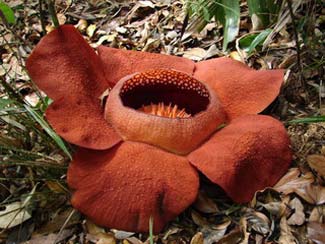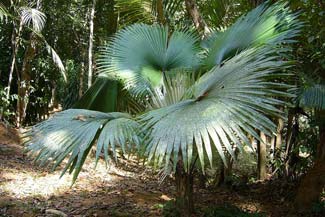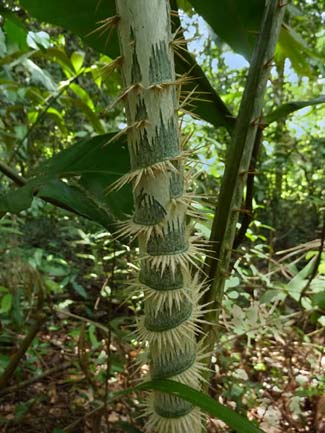Tree Tops Jungle Safaris
Khao Sok National Park

Khao Sok National Park
Flower & Plants
Khao Sok is rich with fruit and vegetation. It boasts approximately 200 different floral species per hectare including a wide variety of orchids and the World’s largest flower, Rafflesia.
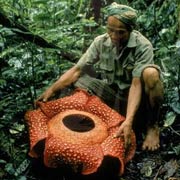 Rafflesia
RafflesiaRafflesia, known locally as Bua Phut (wild lotus), is orange/red in appearance. It has no roots or leaves of its own; instead it lives parasitically inside the roots of the liana. It takes nine months to grow from the size of a small button to a giant football (some reach 80cm in diameter). The Rafflesia only blooms for a few days a year, usually during January and February.
Bamboo
Bamboo is the oldest and largest grass on earth – 60 million years
old and standing up to 10 metres high. It grows very quickly, some species
sprout more than a metre in just 24 hours.
Bamboo is hollow and therefore very flexible and is strengthened by
the sections throughout its length.
Thai people use bamboo to make a broad variety of things – from
rafts and bungalows to furniture, fish traps and cooking utensils. And
of course you can eat it – bamboo shoot salad is delicious!
Banana
There are both male and female banana trees. If the tree has a big flower
it’s a female, a smaller bloom denotes a male.
Many uses
Banana shakes, banana pancakes, the list goes on; this fruit is part
of any tourist’s staple diet! But it’s not just the fruit
that’s used:
 The
flower is boiled with coconut milk to make a tasty soup
The
flower is boiled with coconut milk to make a tasty soup - The leaves serve as food wrappings and plates
- The stalk’s fibres are extremely strong and are used to make rope, string or twine which, in turn, are used to weave baskets, hats and place mats.
- The banana also plays its part in a very important Thai festival. The stalk is used to make floats for the Loi Krathong festival, which takes place every November and pays homage to the goddess of water.
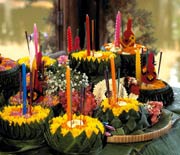

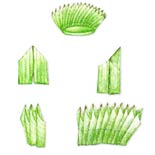
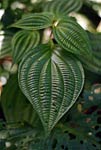 Wild
pepper
Wild
pepper
This climber can grow up to 10 metres, producing young green peppercorn
seeds, which in turn change to red when ripe. You’ll spot them
in many a Thai dish.
Wild ginger
The aromatic roots of this plant are used throughout Thai cuisine. Wild
ginger has a horizontal underground stem which is swollen with food
reserves. This stem contains oils and resins which give off that wonderful
ginger aroma. Not only does it smell gorgeous, but the plant’s
flowers are a beautiful red and pink colour.
Palms
More than 1,300 species of palm grow in Thailand, the greatest concentration
in the world.
From this giant palm comes the tropic’s most important nut – the coconut. Want to find out how old a coconut palm is? Simply, count the layers on its trunk.
A coconut weighs about 3kg and has four layers:
- Outer shell
- Husk
- Kernel
- Coconut meat
- Inside you’ll find a sweet liquid that’s healthy and delicious to drink.
As with the banana, the layers are ingeniously put to good use. The
husk is used to make flowerpots, rugs and baskets, the kernel to make
kitchen tools and the coconut meat, of course, is used in Thai cuisine.
Palm Langkow
This rare palm is listed as the world’s most endangered species.
It’s found in Khao Sok and Khao Phra Taew forest park in Phuket,
and nowhere else on earth!
If you want to be one of the few to have a sighting of this plant, it’s
3-5 metres tall and has large fan-shaped leaves with silver-white undersides.
Rattan Palm
The Rattan Palm is a liana vine. Lianas cleverly rely on other plants
to help them grow, hooking themselves around others so they can quickly
climb their way up into the light.
Extremely strong and flexible, the vines are used to make beautiful
rattan furniture.
Strangler Fig
A liana vine rather than a tree, the Strangler Fig produces copious
amounts of fruit which is gorged on by gibbons, hornbills, wild boar,
deer, macaques, civet, bats and birds.
Spreading the seed
Renowned for being a potent laxative, it doesn’t take long
for the fruit to pass through the animals’ systems! Thus the seeds
get widely spread throughout the forest canopy.
A fig seed that lands on a tree branch can quickly germinate and send
roots down to the trunk of a tree. These roots spread, eventually encircling
the host tree’s trunk and strangling it and robbing it of sunlight.
The trunk of the host tree eventually dies leaving a hollow fig tree
trunk. If you come across a fallen strangler fig trunk you can walk
or crawl through it like a tunnel!
Although the vines effectively kill trees, they are important within
the rainforest. The strong vines link the upper canopies of the forest,
creating aerial bridges for ants, spiders, squirrels and gibbons to
cross.
